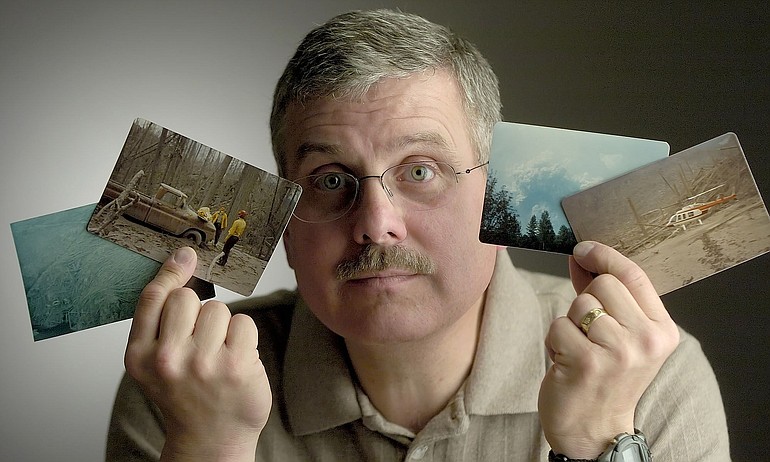Originally published May 15, 2005
For Grover Laseke, the eruption of Mount St. Helens wasn’t a spectacle. It was a grueling, dangerous, serious job.
Grueling as a trek through ash-blasted wasteland, dangerous as a car crash, serious as a body bag: all part of his job in the days following May 18, 1980.
Laseke was a deputy sheriff back then, patrolling a 1,400-square-mile section of eastern Lewis County. He also was the department’s assistant search and rescue coordinator.
The 26-year-old deputy had worked late Saturday night, but when Mount St. Helens erupted at 8:32 a.m., his wife woke him, and Laseke headed back to work.
“I went east on Highway 12, dealing with whatever calls and emergencies that might have come up. People didn’t know what do to, or what was going on. I didn’t necessarily know a lot either, until later on. Ash fell like snow, and was very deep, up to 6 inches, depending on your location.
“Once I entered my patrol area, the ash from the eruption blocked out the sun, and it was almost dark,” he recalled.
“I got together with the Forest Service, and our goal was to check on people in remote areas. We weren’t sure how far the devastation was,” said Laseke, who retired as Woodland police chief last year and now is public safety director at Concordia University in Portland.
Laseke said his group came across only one victim that day, a man who had been camping at Ryan Lake, on the north end of Skamania County.
“He tried to walk out. One of our guys found him alongside the road, dead, his lungs packed full of ash. Over the next several days, we took reports of missing persons and attempted to check on people who were camping or living in remote areas around the mountain.”
More challenges
The task didn’t get any easier in the following days.
“Even driving on state highways was hazardous. Ash clouds flew up and it was difficult to see anything. The day after the eruption, I had a head-on accident with a motor home on White Pass.”
Nobody was supposed to be on the road, but a group of skiers that had been stranded by the eruption decided to make a run for it, Laseke said.
“I could only see about 10 feet, and unfortunately, we had a meeting. I totaled my four-wheel drive and wound up with some cracked ribs.”
The search-and-rescue effort continued as agencies took calls on missing hikers and campers.
“People would get upset if nobody was looking for their family member,” said Laseke, and he recalled a May 28 search for a missing Mossyrock resident along the Green River, north of the volcano.
“You were trudging through ash that, in places, was packed down like snow. In some places, you could step into a hole. It was gritty, and you had to wear a mask. It was amazingly difficult. But if we didn’t look, family members would figure out a way to get into the area.”
They never did find that victim, Keith Moore, but three weeks later more than month after the eruption his group recovered the body of Ron Conner in a horse camp at Ryan Lake.
“We recovered his remains on June 23,” Laseke said. “He was found near an outhouse that was still standing.”
Another view
Laseke hiked the trails and drove the roads, but he got an even better view of the devastation from a helicopter. For vast stretches, trees were knocked flat and everything was flocked in ash. It was hard to keep your bearings straight when all you saw was a soft, flat gray.
“It was surreal,” he said.
That was one reason authorities enforced a “Red Zone” closure for about a year after the eruption, keeping out the curious as well as those whose friends or family members were still missing.
“They thought because they knew the area, they could find their way around,” Laseke said. “The trouble was, the landscape had changed. Also, we didn’t know if the mountain would blow again.
“We worked to keep people out of the Red Zone for the next year or so until the scientists said it wasn’t dangerous anymore.”
No, the eruption wasn’t a spectator sport for Laseke. And it hasn’t been a particularly fond memory in the 25 years since. He did participate in some of the 10th anniversary observances, because, “Some of my colleagues were still around,” he said.
“On the 20th anniversary, I wasn’t interested. Some people have an intense interest in it. I was overloaded.”




